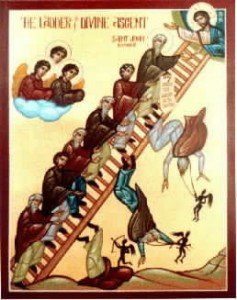 In the last issue I was dealing with the 29th Step on John’s Ladder, namely DISPASSION. One of the aspects of Dispassion is, of course, Theosis. As my readers may know, if they have been following this article, Theosis is the Eastern Church’s spiritual development process by which personal change or transformation is supported. This process has also been called deification. Deification is to become “holy for I am holy” (Leviticus 11:44). So the idea of deification was already represented in the Old Testament (OT) but, since God had not yet become incarnate in the Person of Jesus, the people of the OT had no model that they could imitate. Matthew (5:48) describes it in this manner: the purpose of life is to become “perfect, just as your Father in heaven is perfect”. This has been made possible by the only human being who is God by nature: Jesus Christ. Because the second Person of the Holy Trinity became what we are and shared in our humanity, we can become what He is and share in His divine glory.
In the last issue I was dealing with the 29th Step on John’s Ladder, namely DISPASSION. One of the aspects of Dispassion is, of course, Theosis. As my readers may know, if they have been following this article, Theosis is the Eastern Church’s spiritual development process by which personal change or transformation is supported. This process has also been called deification. Deification is to become “holy for I am holy” (Leviticus 11:44). So the idea of deification was already represented in the Old Testament (OT) but, since God had not yet become incarnate in the Person of Jesus, the people of the OT had no model that they could imitate. Matthew (5:48) describes it in this manner: the purpose of life is to become “perfect, just as your Father in heaven is perfect”. This has been made possible by the only human being who is God by nature: Jesus Christ. Because the second Person of the Holy Trinity became what we are and shared in our humanity, we can become what He is and share in His divine glory.
But if no created being can become God – for He is “beyond all being” – how do we explain this contradiction? The Eastern Church explains it by a distinction between God’s essence (what God is by nature) and His energies (what we can experience of God by His grace and condescension). God is by nature love, and by His grace we become love; He is by nature holy, and by His grace we are made holy; God is by nature eternal, and by His grace we have everlasting life. Maximus the Confessor explained it in the following way:
A sure warrant for looking forward with hope to deification of human nature is provided by the incarnation of God, which makes man god to the same degree as God himself became man.
Theosis, or dispassion, cannot be acquired with the intellect, but only by experience, meaning by synergy. We cannot be saved by faith alone, by grace alone, or by works alone. More the follow.
